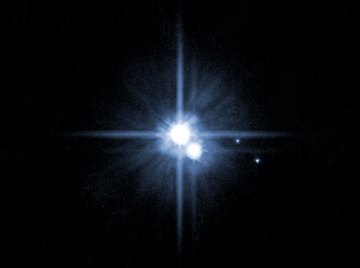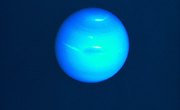
Pluto was once considered the ninth planet in our solar system, but it has now been reclassified as a dwarf planet. Instead of its moon Charon orbiting it, Pluto and Charon are both orbiting a center of gravity in between them. Pluto doesn’t have the sweeping, impressive storms of Jupiter, but it does have windstorms that redistribute the ice covering its surface.
Pluto's Basics
Smaller than our moon, Pluto is only 1,440 miles (just over 2300 kilometers) in diameter -- the distance from Los Angeles to Oklahoma City. Pluto was long considered the farthest planet in our solar system from the sun. While this is generally true, every 228 years, Pluto’s orbit passes in front of Neptune’s, making Neptune farther from the sun for 20 years before the orbits cross again. Gravity on Earth is 15 times that of Pluto's -- if you were able to travel to Pluto you would weigh one-fifteenth what you do on Earth.
Temperature
The temperature on Pluto is colder than anywhere on Earth, as it is 40 times as far from the sun. The average temperature, -390 degrees Fahrenheit (-234 degrees Celsius), is only about 70 degrees Fahrenheit higher than absolute zero, the lowest temperature possible. At these frigid temperatures, the only elements that could exist in a non-frozen state would be helium, hydrogen and neon. Thus rainstorms aren’t possible on Pluto, as it is far too cold; even if water exists there, it would never be warm enough to evaporate and form clouds.
Frost
Clouds or haze cover the surface of Pluto -- scientists aren’t sure which, but they have noticed starlight doesn’t evenly reflect off the planet. This cloud or haze is full of elements that warmed from the surface and turned to gas -- these elements are most likely nitrogen and methane. Frost forms on Pluto when the elements that turned to gas on the sunlit side of the planet are carried to colder, darker regions -- the 120-degree tilt of Pluto's rotational axis leads to stark seasonal variations, large enough that scientists have noted changing levels of frost through telescopic measurements of the infrared wavelengths of reflected sunlight. The frost on Pluto isn’t made of water, as it is on Earth, but is thought to be methane or nitrogen ice. The formation of frost is the main weather occurrence on Pluto.
Wind
Pluto, like Earth, has winds that form from the interaction between hot and cold air and high and low pressure -- these winds are strongest when Pluto's orbit takes it closer to the sun than Neptune. Even though Pluto is far from the sun, the sun still has powerful effects on it, warming it to the point that it can have an atmosphere and winds. The winds on Pluto also create sublimation, or the change of an element from solid to gas. Through sublimation the winds are responsible for shifting the ice cover on the planet. The speed of Pluto's atmospheric winds, while once thought to be higher, has recently been estimated at only around 37 kilometers (23 miles) per hour, according to research scientist Angela Zalucha at the SETI Institute.
New Horizons
More observation and research is needed to completely understand Pluto’s weather. NASA launched a spacecraft in 2006 to study Pluto, and the Kuiper Belt beyond. The research craft New Horizons should reach Pluto by 2015. New Horizons has already discovered two new moons of Pluto, currently called P4 and P5. Just as Earth’s moon influences tides, these new moons may have unknown effects on Pluto or Pluto’s weather. Pluto already had three known moons before the mission: Hydra, Nix, and Charon. New Horizons will study Pluto’s atmosphere with radio waves and ultraviolet light.
References
- Smithsonian Air and Space Museum: Pluto’s Unusual Orbit
- Smithsonian Air and Space Museum: Pluto Facts
- Smithsonian Air and Space Museum: Pluto and Charon
- JHU/APL: New Horizons
- NPR: Why The Former Planet Pluto Got Demoted
- Southwest Research Institute: The SWAP Instrument Aboard New Horizons
- Mount Washington Observatory: The Story of the World Record Wind
- University of Illinois Champaign Urbana: Wind Formation
About the Author
Kelly MacGregor holds bachelor's degrees in news-editorial journalism and ecology/evolutionary biology from the University of Colorado at Boulder. In addition to writing for the "Colorado Engineer Magazine," the "Boulder Daily Camera" and EdNews Parent, MacGregor's work has been picked up by the "Colorado Daily," EdNews Colorado and the "Denver Post."
Photo Credits
NASA/Getty Images News/Getty Images
